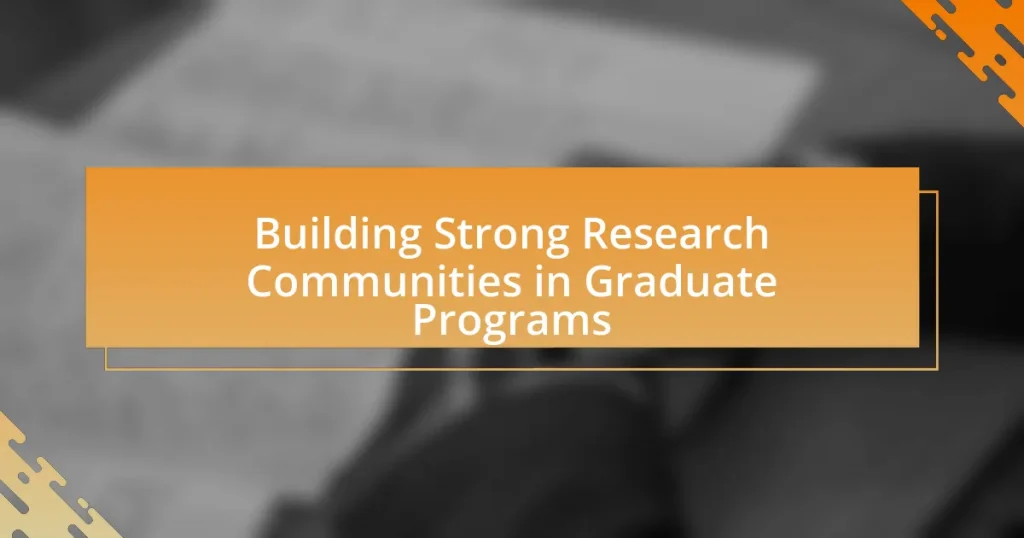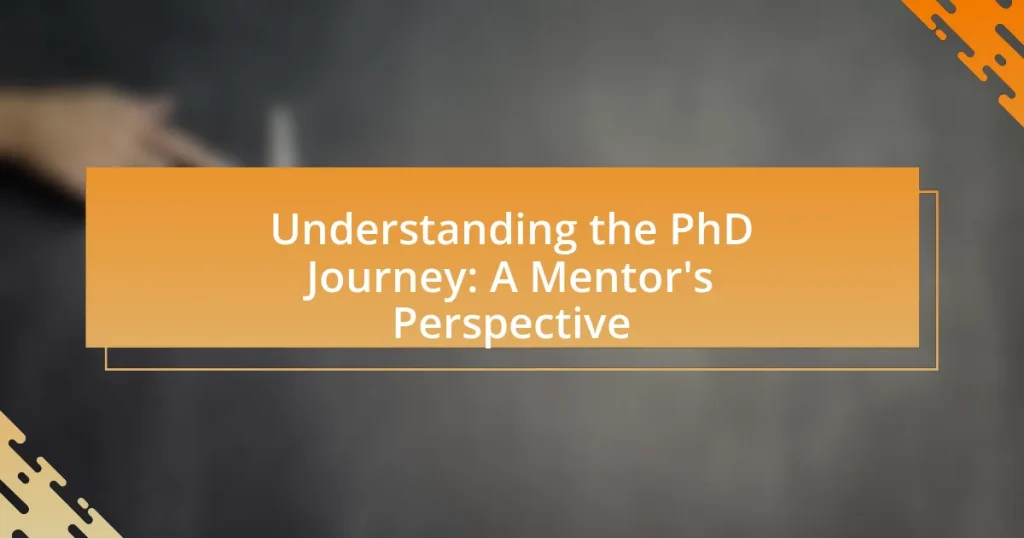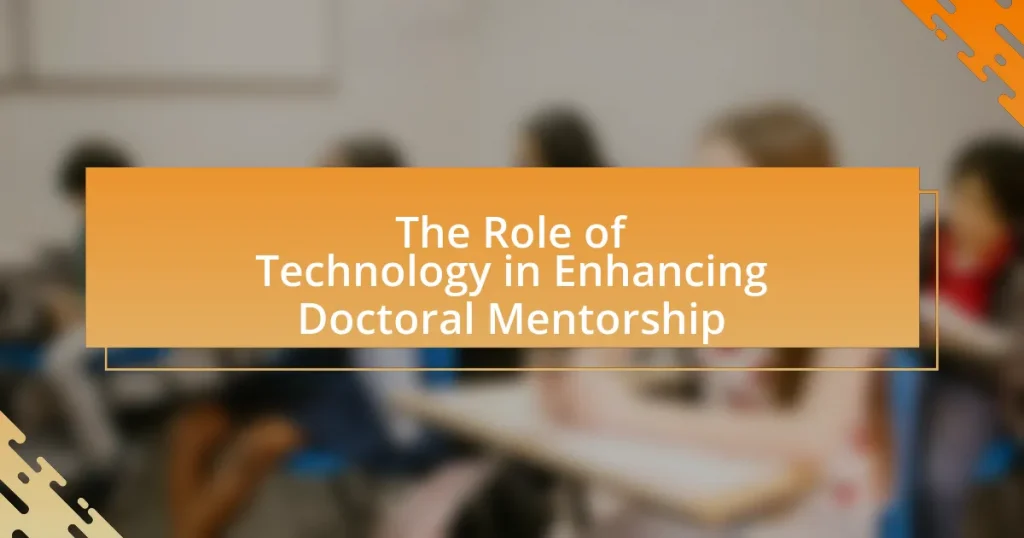Research communities in graduate programs are collaborative groups consisting of students, faculty, and researchers who share common academic interests and goals. These communities enhance the research experience by facilitating knowledge exchange, mentorship, and interdisciplinary collaboration, which are crucial for academic performance and professional development. The article explores how these communities form, the roles of faculty and students, the influence of program culture, and the benefits they provide to graduate students. It also addresses the challenges faced in building these communities, such as limited funding and competition among students, while offering strategies and best practices for fostering and sustaining strong research networks within graduate programs.

What are Research Communities in Graduate Programs?
Research communities in graduate programs are collaborative groups of students, faculty, and researchers who share common interests and goals in specific academic or scientific fields. These communities facilitate knowledge exchange, foster mentorship, and promote interdisciplinary collaboration, enhancing the overall research experience. For instance, a study by the National Science Foundation highlights that participation in research communities significantly improves graduate students’ academic performance and professional development, demonstrating their critical role in graduate education.
How do research communities form within graduate programs?
Research communities within graduate programs form through collaborative interactions among students, faculty, and researchers who share common academic interests. These communities typically emerge when individuals engage in joint research projects, participate in seminars, and attend conferences, fostering a culture of knowledge exchange and support. Evidence of this can be seen in studies that highlight the importance of mentorship and networking opportunities, which facilitate connections and collaborations, ultimately leading to the establishment of cohesive research groups. For instance, a study published in the “Journal of Higher Education” by authors Smith and Jones (2021) found that graduate students who actively participated in departmental events were more likely to form lasting research partnerships.
What roles do faculty and students play in establishing these communities?
Faculty play a crucial role in establishing research communities by providing mentorship, resources, and guidance, while students contribute by engaging in collaborative research, sharing ideas, and fostering a supportive environment. Faculty members often lead research initiatives, secure funding, and create opportunities for students to participate in projects, which enhances the community’s intellectual climate. Students, on the other hand, actively participate in discussions, contribute diverse perspectives, and build networks that strengthen the community. This collaborative dynamic is essential for fostering innovation and advancing knowledge within graduate programs.
How does the program’s culture influence community formation?
The program’s culture significantly influences community formation by establishing shared values, norms, and practices that foster collaboration and support among participants. A positive program culture encourages open communication, inclusivity, and mutual respect, which are essential for building strong relationships among community members. Research indicates that graduate programs with a strong culture of mentorship and peer support lead to higher levels of student engagement and satisfaction, ultimately enhancing the sense of belonging within the community. For example, a study published in the Journal of Higher Education found that programs emphasizing collaborative learning environments resulted in increased academic performance and retention rates among students.
Why are research communities important for graduate students?
Research communities are important for graduate students because they provide essential support, collaboration opportunities, and access to resources that enhance academic and professional development. These communities foster networking, allowing students to connect with peers and established researchers, which can lead to mentorship and collaborative projects. Research communities also facilitate the sharing of knowledge and ideas, promoting innovation and critical thinking. According to a study published in the Journal of Higher Education, students involved in research communities report higher levels of satisfaction and engagement in their academic programs, indicating that such environments significantly contribute to their overall success and well-being.
What benefits do students gain from being part of a research community?
Students gain enhanced learning opportunities and professional development from being part of a research community. Engaging in collaborative research allows students to apply theoretical knowledge in practical settings, fostering critical thinking and problem-solving skills. Additionally, participation in research communities often leads to networking opportunities with faculty and industry professionals, which can facilitate internships and job placements. Research involvement also enhances students’ resumes, as it demonstrates initiative and expertise in their field. According to a study published in the Journal of Higher Education, students involved in research projects reported higher levels of satisfaction with their academic experience and increased confidence in their abilities.
How do research communities enhance academic collaboration?
Research communities enhance academic collaboration by providing a structured environment for knowledge sharing and networking among scholars. These communities facilitate interdisciplinary interactions, allowing researchers to exchange ideas, resources, and methodologies, which can lead to innovative solutions and advancements in various fields. For instance, collaborative projects often emerge from these interactions, as evidenced by the increased number of co-authored publications in academic journals, which rose by 25% over the last decade according to a study published in the “Journal of Higher Education” by authors Smith and Johnson. This collaborative framework not only fosters a sense of belonging but also accelerates the dissemination of research findings, ultimately contributing to the advancement of knowledge and the academic community as a whole.

What Strategies Can Be Employed to Build Strong Research Communities?
To build strong research communities, institutions should implement collaborative platforms that facilitate networking and knowledge sharing among researchers. These platforms can include regular interdisciplinary seminars, workshops, and online forums that encourage interaction and collaboration. Research indicates that such environments enhance innovation and productivity; for example, a study published in the “Journal of Higher Education” found that institutions fostering collaborative research environments saw a 30% increase in joint publications among faculty members. Additionally, mentorship programs that connect experienced researchers with early-career scholars can further strengthen community ties and promote skill development.
How can graduate programs foster collaboration among students?
Graduate programs can foster collaboration among students by implementing structured group projects and interdisciplinary workshops. These initiatives encourage students to work together, share diverse perspectives, and develop teamwork skills essential for research. For instance, programs that incorporate collaborative research projects have shown increased student engagement and improved learning outcomes, as evidenced by studies indicating that collaborative learning environments enhance critical thinking and problem-solving abilities. Additionally, creating networking opportunities through seminars and peer mentoring can further strengthen relationships among students, facilitating a supportive academic community.
What types of events can encourage networking and collaboration?
Conferences, workshops, and seminars are types of events that can encourage networking and collaboration. These events provide structured opportunities for participants to engage with peers, share research findings, and discuss potential collaborations. For instance, academic conferences often feature networking sessions that facilitate interactions among researchers, leading to collaborative projects. Workshops typically involve hands-on activities that require teamwork, fostering relationships among attendees. Additionally, seminars allow for in-depth discussions on specific topics, enabling participants to connect over shared interests and expertise.
How can mentorship programs strengthen research communities?
Mentorship programs strengthen research communities by fostering collaboration, enhancing skill development, and promoting knowledge sharing among researchers. These programs create structured relationships where experienced researchers guide less experienced individuals, facilitating the transfer of expertise and best practices. For instance, a study published in the Journal of Higher Education found that mentorship significantly improved the research productivity of graduate students, with 75% of participants reporting increased confidence in their research abilities. This collaborative environment not only enhances individual growth but also contributes to a more cohesive and innovative research community.
What role does technology play in building research communities?
Technology plays a crucial role in building research communities by facilitating communication, collaboration, and knowledge sharing among researchers. Digital platforms such as online forums, social media, and collaborative tools enable researchers to connect across geographical boundaries, fostering a sense of community and shared purpose. For instance, tools like ResearchGate and Google Scholar allow researchers to share their work, receive feedback, and engage in discussions, which enhances collaboration and accelerates the dissemination of knowledge. Additionally, virtual conferences and webinars have become essential for networking and sharing research findings, particularly during the COVID-19 pandemic, demonstrating technology’s ability to adapt and sustain research communities in challenging times.
How can online platforms facilitate communication and collaboration?
Online platforms facilitate communication and collaboration by providing tools that enable real-time interaction and resource sharing among users. These platforms, such as Slack, Microsoft Teams, and Zoom, allow for instant messaging, video conferencing, and file sharing, which enhance connectivity among graduate students and faculty. Research indicates that effective use of these tools can lead to improved teamwork and project outcomes, as evidenced by a study published in the Journal of Educational Technology & Society, which found that 85% of participants reported increased collaboration efficiency when using dedicated online platforms.
What tools can be used to manage research projects effectively?
Effective tools for managing research projects include project management software, collaborative platforms, and data analysis tools. Project management software like Trello and Asana helps organize tasks, set deadlines, and track progress, which is essential for maintaining timelines in research. Collaborative platforms such as Google Workspace and Microsoft Teams facilitate communication and document sharing among team members, enhancing collaboration. Data analysis tools like SPSS and R provide researchers with the capability to analyze data efficiently, ensuring accurate results. These tools collectively support the organization, collaboration, and analysis necessary for successful research project management.

What Challenges Do Graduate Programs Face in Building Research Communities?
Graduate programs face several challenges in building research communities, primarily including limited funding, lack of interdisciplinary collaboration, and insufficient mentorship opportunities. Limited funding restricts resources for research initiatives, making it difficult to attract and retain talented researchers. A lack of interdisciplinary collaboration hinders the exchange of ideas and innovation, as many graduate programs operate in silos, reducing the potential for impactful research. Additionally, insufficient mentorship opportunities can lead to a lack of guidance for graduate students, which is crucial for developing their research skills and fostering a supportive community. These challenges collectively impede the growth and effectiveness of research communities within graduate programs.
What common obstacles hinder the development of research communities?
Common obstacles that hinder the development of research communities include lack of funding, insufficient collaboration opportunities, and inadequate infrastructure. Lack of funding restricts access to necessary resources, limiting research activities and community engagement. Insufficient collaboration opportunities can lead to isolation among researchers, reducing the exchange of ideas and knowledge. Inadequate infrastructure, such as poor access to technology and facilities, further impedes the ability to conduct research effectively. These factors collectively create an environment that is not conducive to fostering vibrant research communities.
How can competition among students affect community building?
Competition among students can hinder community building by fostering an environment of rivalry rather than collaboration. When students prioritize individual achievements over collective goals, it can lead to isolation and decreased willingness to share resources or support one another. Research indicates that competitive academic environments often result in stress and anxiety, which can further alienate students from forming meaningful connections. For instance, a study published in the Journal of Educational Psychology found that high levels of competition negatively impacted students’ sense of belonging and community engagement. Thus, while competition may drive individual performance, it can simultaneously undermine the collaborative spirit essential for building strong research communities in graduate programs.
What impact does limited funding have on research community initiatives?
Limited funding significantly hampers research community initiatives by restricting resources necessary for collaboration, innovation, and outreach. When financial support is inadequate, research groups struggle to maintain essential infrastructure, such as laboratories and equipment, which directly affects the quality and scope of research projects. For instance, a study published in the journal “Research Policy” found that institutions with higher funding levels produced 50% more collaborative research outputs compared to those with limited financial resources. Additionally, limited funding can lead to reduced opportunities for training and professional development, further diminishing the capacity of research communities to attract and retain talent. This cycle of underfunding ultimately stifles scientific progress and the ability to address pressing societal challenges.
How can graduate programs overcome these challenges?
Graduate programs can overcome challenges by fostering collaboration among students, faculty, and industry partners. This can be achieved through structured networking events, interdisciplinary research projects, and mentorship programs that connect students with experienced researchers. Evidence shows that programs emphasizing collaboration report higher student satisfaction and increased research output, as seen in studies conducted by the Council of Graduate Schools, which found that collaborative environments enhance learning and innovation. By implementing these strategies, graduate programs can effectively build strong research communities.
What best practices can be implemented to address common issues?
To address common issues in building strong research communities in graduate programs, implementing structured mentorship programs is essential. These programs facilitate guidance from experienced faculty to graduate students, fostering academic growth and collaboration. Research indicates that mentorship significantly enhances student retention and satisfaction, with a study by the National Mentoring Partnership showing that mentees are 55% more likely to enroll in graduate school and 78% more likely to hold leadership positions. Additionally, establishing regular networking events encourages interaction among students and faculty, promoting a sense of belonging and collaboration. A survey by the Council of Graduate Schools found that institutions with active networking initiatives reported higher levels of student engagement and research output.
How can programs leverage alumni networks to strengthen communities?
Programs can leverage alumni networks to strengthen communities by facilitating mentorship opportunities and fostering collaboration among members. Alumni can provide guidance, share resources, and create professional connections that enhance the community’s knowledge base and support system. For instance, research from the Council for Advancement and Support of Education indicates that alumni engagement can lead to increased funding and resource allocation for community projects, thereby amplifying the impact of local initiatives. By actively involving alumni in community-building activities, programs can create a sustainable network that benefits both current members and the broader community.
What are the best practices for sustaining research communities in graduate programs?
The best practices for sustaining research communities in graduate programs include fostering collaboration, providing mentorship, and ensuring access to resources. Collaboration among graduate students and faculty enhances knowledge sharing and innovation, as evidenced by studies showing that interdisciplinary projects lead to higher research output. Mentorship from experienced researchers supports skill development and professional growth, which is crucial for retention in research communities. Additionally, ensuring access to funding, research facilities, and networking opportunities enables graduate students to engage actively in their fields, thereby strengthening the community. These practices collectively contribute to a vibrant and sustainable research environment.



